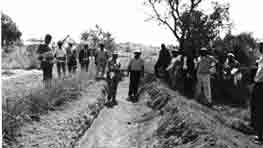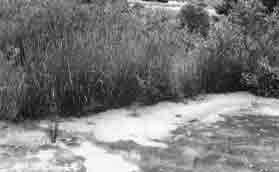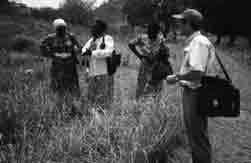
by Soren Dreyer (MSC in Geography) Conservation Adviser, Zaka District.
Background
Zimbabwe has a long and politically quite shaky history of soil conservation. Construction of standardized contour ridges and drains has been enforced by governments for decades and due to the enforcement the whole idea of soil conservation has become rather unpopular among communal (African small-holder or peasant) farmers. During the liberation war of the 1970's the concept of "Freedom Farming" was introduced by the freedom fighting armies. This involved destruction of existing contour ridges as a protest against the Rhodesian regime. Hence, soil conservation became a victim in a highly sensitive and indeed political debate. Now, 17 years after independence, the standard contour ridges are to some extent still enforced, but it is now possible to establish other means of soil conservation without actually bypassing the law.

Photo # 1: Transforming a standard contour ridge & drain into a Vetiver hedge. Vetiver is planted just above the drain. This photo was taken after the first season and the hedge is already well established. After the second season the drain and ridge will be destroyed giving the farmer access to more land while the field is better protected. The photo was taken during a "Look & Learn Tour" with visitors from another district.
In Zaka District, in South-Eastern Zimbabwe, a partnership between the Danish NGO MS-Zimbabwe and the local Rural District Council started 4 years ago with the objective of addressing conservation of natural resources among communal farmers. The idea was to introduce options for appropriate technologies to control soil erosion instead of blank recommendations (like the standard contour ridge). The program is coordinated by Zaka Rural District Council, and the implementing agents are Ministry of Agriculture, Dep. of Natural Resources, and the Forestry Commission of Zimbabwe. A Danish Conservation Adviser is attached to the programme.
Zaka District is a semi-arid, mountainous area with erratic rainfall averaging 6-800 mm/yr. The soils are generally poor. Subsistence farming is the main economic activity and the main crops grown are maize, groundnuts, cotton, sorghum finger millet, sunflower and pumpkins. The population density is more than 65 persons/km2, which is quite high for a mountainous area where subsistence farming is the main economic activity. Hence the environmental consequences are over-utilization of the natural resources, deforestation and severe soil erosion.
Initially, the conservation programme introduced an alternative type of mechanical contouring, the Fanya Juu system from Kenya. By building up bench terraces and improving moisture conservation this system reduces soil erosion markedly compared to the standard contour ridges. Yet, it was felt that more alternatives were needed, and vetiver grass (Vetiveria zizanioides) was then introduced in 1994. In the beginning only as a pilot project, because experience with the grass in Zimbabwe's communal areas was minimal. A few nurseries (0.2-0.4 ha) and a number of demonstrations with contour hedges were established. The planting material was bought from large scale commercial farms in other parts of the country where Vetiver had successfully been used for some 20-25 years, but never really reached the communal areas.
Even within the first season, the results were quite impressive. The second largest gully in Zimbabwe, at Zishir (>300m long, 15-20m wide and 10-12m deep), was one of the main targets. Conservation of the gully catchment area with vetiver contour hedges proved to be much more efficient than the standard contour ridges. Later, waterways leading to the gully were checked with vetiver, and two more nurseries were established inside the gully to provide optimum moisture conditions.

Photo # 2: Checking runoff. A Vetiver hedge planted across a road, which used to cross a valley bottom. The valley bottom is now a 10-12m deep gully and the road a dangerous waterway leading to the gully. Vetiver hedges were planted 11/2 year before the photo was taken, and in spite of the poor soil conditions the grass is well established and the amount of silt trapped in front of the hedge is quite impressive. The hedge also facilitates establishment of other types of vegetation, which further reduces the velocity of runoff and thereby assists the reclamation of the gully.
To ensure sustainability and reduce dependency of purchasing the grass from commercial farms two large central nurseries were established at a later stage. From there, farmers will be able to purchase planting material at a reasonable price with low transport costs. These two district nurseries are still new and are not able to meet the high demand from farmers, who have realized the many advantages of vetiver contour hedges. The advantages stated by the farmers are:
I have not come across any research on the latter issue, but cobras and mambas flourish in Zaka, so if it really works, all the better.
The statement of "no erosion in the fields" is related to the fact that sheet and even rill erosion are common phenomena's in the fields conserved with standard contour ridges. Rill erosion mainly occurs where there are breakage's in the contour ridge or where the ridge was not pegged correctly. Sheet (inter-rill) erosion does take place in fields with vetiver hedges, but it is reduced significantly due to circumstance that vetiver is a permeable barrier that acts like a sieve and kind of spreads runoff water right across the field and reduces the erosivevelocity of runoff water. Thus, the total erosion and the visible signs of it in the field might be reduced, but the sedimentation of material in front of the hedge (which eventually becomes a natural terrace) proves that erosion in the field does take place. The main advantage with vetiver hedges is thus that soil is only transported within the field and not removed from it. Based on the positive results from the pilot sites it was decided to establish community nurseries in each of the 30 wards of Zaka District and at a number of schools.
Dissemination
The concept of biological contouring in the form of vetiver grass barriers immediately appears strange to a farmer who has never seen it and who in the past was forced to practice mechanical contouring. So the most efficient tool in disseminating the concept of vetiver grass hedges proved to be "Look & Learn Tours" for farmers.

Photo # 3: Farmer-to-farmer extension. During a "Look & Learn Tours farmers explain to other farmers their experiences with vetiver grass. Here Mrs. Zinanga, an innovative farmer, is teaching two visitors how to manage a Vetiver nursery. Note that the "donor" in the right front is keeping quiet, listening in admiration!
On the "Look & Learn Tours" interested groups and individuals visit the pilot areas. During the visits, the farmers from the pilot areas explain in their own words what they have done, show how they have done it, and prove what they have achieved. The aspects of vegetative propagation and of managing and maintaining a permanent nursery is well displayed by simply comparing the propagation of Vetiver to that of shallots, a practice most farmers are familiar with from their gardening.
The visible proof in the pilot plots of Vetiver's viability as a highly advanced yet at the same time simple option for soil & water conservation convinces almost every visitor. After the tour, the visitors are usually very keen and are encouraged to start their own nurseries. That, however, is not always possible and depends on the season. Due to vetiver's vulnerability to drought the first 6-8 weeks and the local rainfall pattern, nurseries and contour hedges should only be established from December to February in this part of the world; unless there is a permanent water source very near the nursery and the community is prepared to water the grass. In Zaka we have tried to establish nurseries in the dry season with limited success. There have been cases where grass planted in the dry season (even near a water source, has dried up due to negligence. One factor could be, that too heavy promotion of the blessings of Vetiver from eager extensionists (including the author!) has made some beneficiaries believe that the grass can grow even without water! But apart from the first 6-8 weeks where water is essential, nothing else seems to disturb vetiver seriously. Termite and livestock attacks are common, but in most cases the grass survives and will re-shoot.
In addition to the farmer-to-farmer extension via the "Look and Learn Tours", school teachers and the agricultural extension staff of the district have also been trained in Vetiver management. This training has provided the programme with valuable resource persons scattered all over the district. Here, the little green Vetiver Handbook has been highly valuable, as we received 150 copies in 1995. They are all distributed and are being used intensively. We could use more copies, also for distribution to other districts, so an effort to have the handbook re-printed would be highly appreciated! To reach beneficiaries that are not too confident with the English language, a handout in Shona on vetiver management is now being produced.
Sustainability and Potential
By just introducing vetiver grass in Zaka District, all the environmental problems described in the first section of this paper are far from solved. But vetiver hedges has proven to be a more efficient, less laborious and easily adoptable barrier against erosion compared to mechanical contouring methods like contour ridges. And it has proven to be an almost universal and comparably cheap tool in gully reclamation. There is still a lot of areas where we need more experience here in Zaka, e.g. in soil conservation along roads, embankment stabilization and in the protection of wetlands. There is definitely more work to be done and new areas to explore...
Based on the above findings vetiver grass has a high potential of being the solution to the problem of soil erosion in Zimbabwe. With the recent experiences from Communal Areas (in at least 4 other districts than Zaka), and the many years of experiences on commercial farms, there should be no reason for the government and the many donors in Zimbabwe not to focus first of all on vetiver hedges as an alternative to the unpopular standard contour ridges. The grass deserves much more attention than it currently receives.
Environmentally, there is no doubt that Vetiver is one of the best solutions to conservation of arable lands as well as grazing areas. It is easy for farmers to learn the skills related to management of the grass, there are no expenses when first the grass is there, and the labour requirements are very low. The only concern we have in this programme is related to the fact that Vetiveria zizanioides seems to be a clone; we don't know what diseases or pests might appear one day and within a short period damage or even exterminate all the grass in the region. That would be an environmental disaster. But considering the worldwide experience and proof of the viability, the risk appears to be mainly theoretical. Hence, Vetiver grass has a lot of potential in Zimbabwe and based on the Zaka farmers' positive response it should be worth trying on a much larger scale.